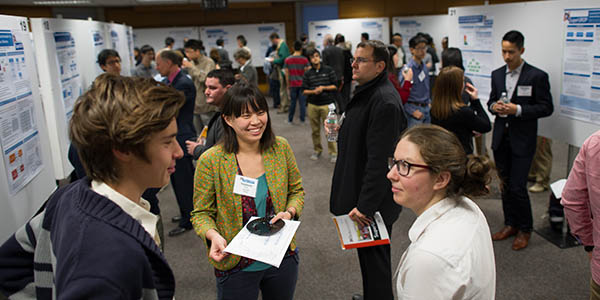
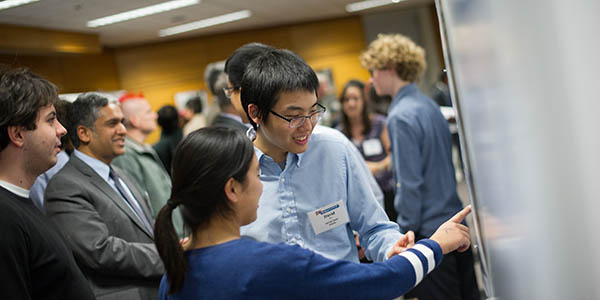
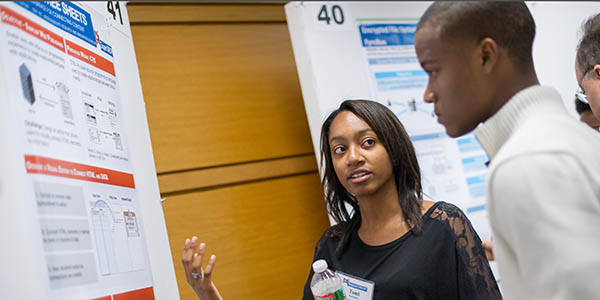
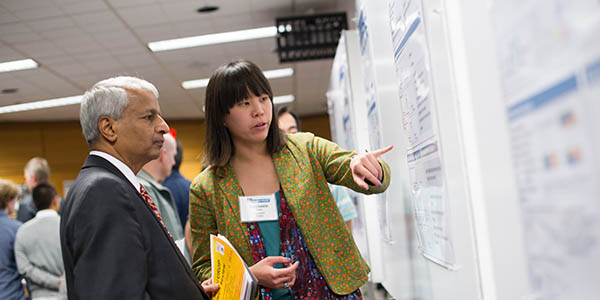
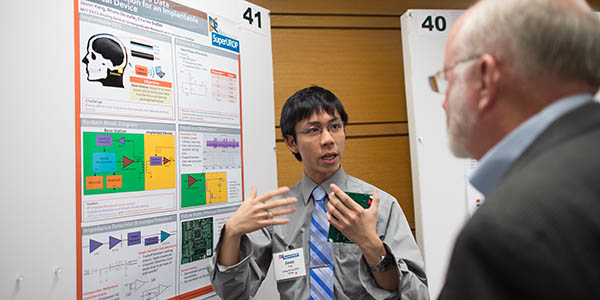
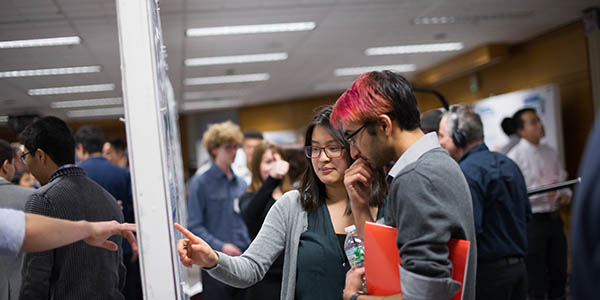
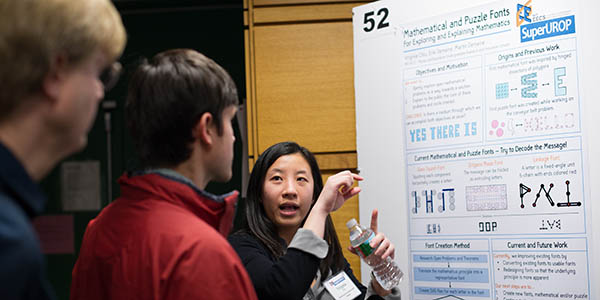
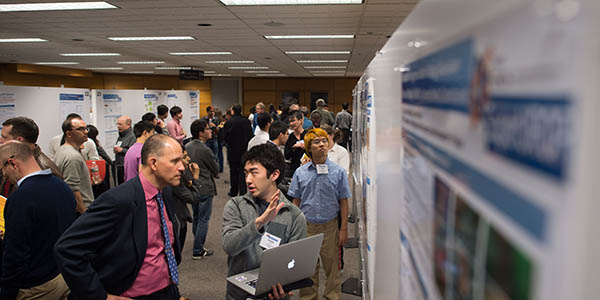
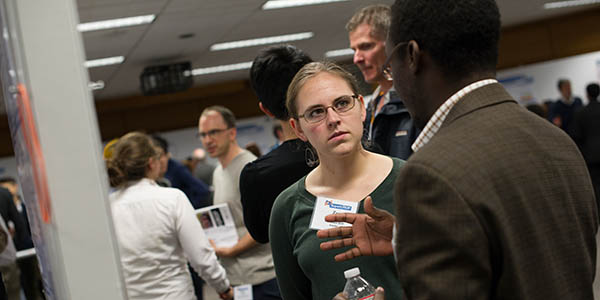
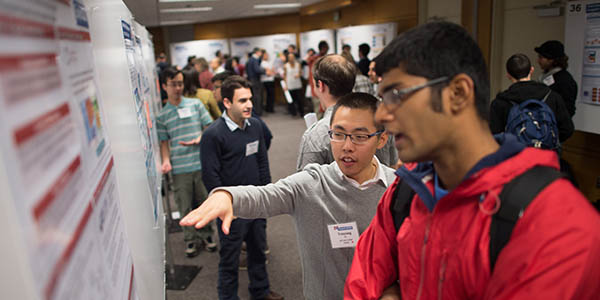
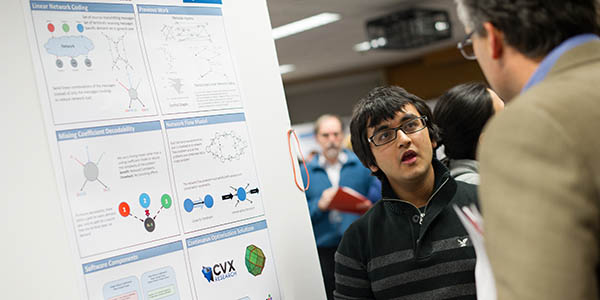


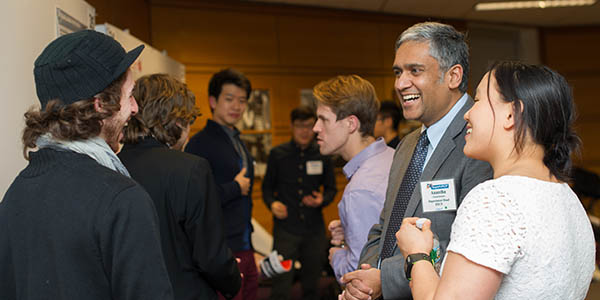


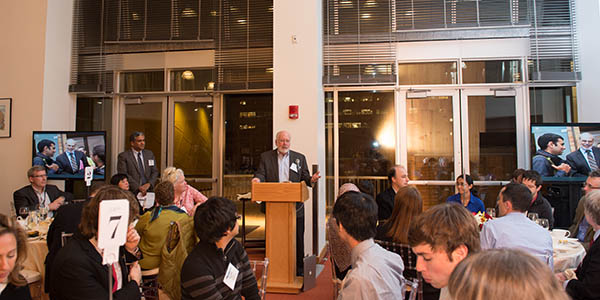
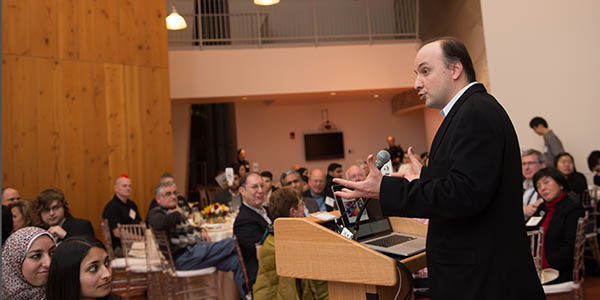
In it’s third year, SuperUROP is having a positive impact
Kathryn O'Neill
Faculty, students, and industry representatives packed MIT’s Grier Room on Thursday, Dec. 4, to learn about new research in robotics, machine learning, wireless power transfer, synthetic biology, and more—all being conducted by undergraduates through the groundbreaking SuperUROP program within Electrical Engineering and Computer Science (EECS). [See the video clip.]
“My feeling is some of this work is as good as master’s quality research. It’s very good stuff,” said Vincent Chan, the Joan and Irwin M. Jacobs professor of electrical engineering and aeronautics and astronautics, who is advising two SuperUROP students this year.
“We are creating a community of scholars. As they are exposed to the breadth of research in EECS, their excitement and enthusiasm to engage in research and innovation is contagious,” said Anantha Chandrakasan, Joseph F. and Nancy P. Keithley professor of electrical engineering and EECS department head, who launched the year-long SuperUROP research program in 2012 to expand the experience familiar to many through MIT’s Undergraduate Research Opportunities Program (UROP). While UROPs also enable students to conduct research, the SuperUROP program includes a two-term course on undergraduate research and requires participants to produce prototypes or publication-worthy results by the end of the year.
“They learn what it is to do research,” said Ted Equi, EECS SuperUROP industrial liaison, noting that the program has already grown from 80 to more than 100 participants with more expected in the years to come. “That's a fundamental goal of SuperUROP—to have undergraduates experience more of a structured, long-term research engagement.”
Taibo Li ’15 said the program has inspired him to pursue a PhD in health science and technologies. “The SuperUROP program helped me find my passion in multidisciplinary research in EECS and medicine,” said Li, who is working with Professor Thomas Heldt to develop an algorithm to suppress false bedside monitoring alarms in intensive care units. He noted that SuperUROP has given him the chance to interact regularly with top faculty, industrial, and clinical advisors.
104 undergraduate researchers
The mid-year review featured poster presentations by 104 students on work related to energy efficiency, health care, image processing, system optimization, and much more. More than fifty representatives from the program’s more than 20 industry and individual sponsors circled the room to learn about the student projects.
Evidence suggests they were impressed
“This is rapid prototyping at its best,” said Cathy Wicks, university program manager for Texas Instruments, noting that the company supports SuperUROP in part to see how its chips work in various student applications. “We learn a lot from [the students’] experiences.”
Mitchell Schneir, director of talent acquisition at information technology firm Actifio, said about 15 people from his company attended the research review. “For us this is good because it’s a different level of recruiting. We can really tell where the talent is,” he said.
Having fun with serious research
Students remarked that meeting industry representatives and gaining experience presenting their work are among the extras that make SuperUROP worthwhile. “I think practicing presenting to others really helps,” said Andrew Song ’15, who is researching optical networks with Chan.
Mihika Prabhu ’15, who is working with Assistant Professor Dirk Englund to develop a quantum photonic processor, agreed, noting that SuperUROP is providing her with “very beneficial training in the technical and communication skills necessary to perform research in the field.”
Veronica Lane ’15 said she has found the SuperUROP experience both fun and challenging. “When I was in high school, I never imagined that I would be working on cutting-edge robotics,” said Lane, who is being advised by Associate Professor Russell Tedrake in developing software that will enable a quadrupedal robot to run over rough terrain. “I’m basically getting paid to have fun. I’m working on these awesome robots. It’s a dream.”
SuperUROP students receive a monthly stipend for their lab work and get credit for the seminar course 6.UAR, but the program also pays off handsomely for faculty, Tedrake said. “SuperUROP has helped us recruit the very best students. It’s more lucrative for them, so we get a lot more out of them,” he said.
Perhaps that’s one reason more than 50 faculty and research staff members from the EECS department supervise SuperUROPs. Certainly, the success of the program is irrefutable—already it has piqued the interest of others at MIT, according to Tedrake. “The word is out that it’s amazing, so other departments are trying to emulate this.”
That’s good news from Lane’s perspective. “This program has been one of the highlights of my academic experience at MIT,” she said. “Hopefully, in the future, SuperUROP will become an Institute-wide program, so that any undergraduate can participate.”
Celebratory dinner
After the poster session, students joined faculty members and industry partners at a dinner in the R&D common area at the Stata Center to celebrate the success of the program. Sam Fuller, CTO of Analog Devices, SuperUROP’s first sponsor, told those gathered, “What I like about the SuperUROP program is that it’s a chance for highly motivated students to see what it’s like to make a unique technical contribution.”
Ishwarya Ananthabhotla ’15, who completed her SuperUROP last year, also addressed the crowd briefly, describing SuperUROP as an “awesome” experience that provides “incredible exposure to the field.”
Dinner guests were then treated to an inside peek at the cutting-edge research MIT is planning through MIT.nano, a new Institute initiative. Vladimir Bulovic, MIT School of Engineering Associate Dean for Innovation, gave a presentation titled “Why the Future Will Be Measured in Nanometers” in which he described the prospects for nanotechnology to revolutionize the food industry, medicine, cloud computing, and more. “If I can control the nanoscale, maybe I can build the world I want,” he said.
Emphasizing that the students in the room would be on the front lines of these developments, he said it’s MIT’s job to give them the tools they need to succeed. “It’s time for you to start inventing the future,” he said.
Apparently, that’s just what the SuperUROP students have in mind.
“When I leave MIT I want to be able to say I made a significant contribution to the research community,” said Youyang Gu ’15. “SuperUROP is a great starting point for that.”
Also appearing in MIT News.
News Image:
